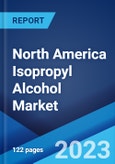Isopropyl alcohol (C3H7OH), also known as isopropanol, is a colorless, volatile and flammable chemical compound with a distinctive odor. It is miscible with various essential oils, removes flux, helps in sterilization, cleansing and deicing, and has several anti-bacterial and anti-fungal benefits. Apart from this, the alcohol has long shelf life and is widely available at affordable prices. Owing to this, isopropyl alcohol is employed across diverse sectors such as pharmaceuticals, personal care and cosmetics, food processing, paints and coatings, printing, automotive, and liquid detergents.
North America represents one of the largest markets for isopropyl alcohol owing to the increasing demand in the pharmaceutical industry. Rapid influx of several products such as alcohol wipes and swabs, hand sanitizers, oral mouthwash, and eardrops has fuelled the demand for isopropyl alcohol in the region. Moreover, blooming food and beverage industry has also contributed to the increasing demand. Rising consumer health awareness of the antibacterial and antiseptic benefits of isopropyl alcohol will continue to spur the demand in the upcoming years.
Key Market Segmentation:
The publisher provides an analysis of the key trends in each sub-segment of the North America isopropyl alcohol market report, along with forecasts at the regional and country level from 2023-2028. The report has categorized the market based on application and end-use industry.Key Regions Analyzed
- United States
- Canada
- Mexico
- Analysis for Each Country
Market by Application
- Process Solvent
- Cleaning Agent
- Coating Solvent
- Intermediate
- Others
Market by End-Use Industry
- Cosmetics and Personal Care
- Pharmaceuticals
- Food and Beverages
- Paints and Coatings
- Chemicals
- Others
Value Chain Analysis
- Key Drivers and Challenges
- Porters Five Forces Analysis
- PESTEL Analysis
- Government Regulations
- Competitive Landscape
- Competitive Structure
- Key Player Profiles
Key Questions Answered in This Report:
- How has the North America isopropyl alcohol market performed so far and how will it perform in the coming years?
- What are the key regions in the North America isopropyl alcohol market?
- What has been the impact of COVID-19 on the North America isopropyl alcohol market?
- What is the breakup of the North America isopropyl alcohol market on the basis of application?
- What is the breakup of the North America isopropyl alcohol market on the basis of end-use industry?
- What are the various stages in the value chain of the North America isopropyl alcohol industry?
- What are the key driving factors and challenges in the North America isopropyl alcohol industry?
- What is the structure of the North America isopropyl alcohol industry and who are the key players?
- What is the degree of competition in the North America isopropyl alcohol industry?
- What are the profit margins in the North America isopropyl alcohol industry?
Table of Contents
Methodology

LOADING...
Table Information
| Report Attribute | Details |
|---|---|
| No. of Pages | 122 |
| Published | September 2023 |
| Forecast Period | 2022 - 2028 |
| Estimated Market Value in 2022 | 954000 Tons |
| Forecasted Market Value by 2028 | 1099000 Tons |
| Compound Annual Growth Rate | 2.4% |
| Regions Covered | North America |









